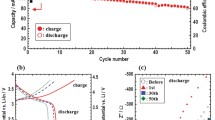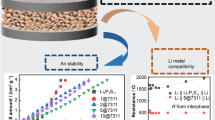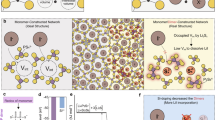Abstract
Solid electrolytes in the system Li2S–P2S5 are attractive for all-solid-state lithium batteries since the electrolytes have high lithium ion conductivities and wide electrochemical windows. In particular, the 75Li2S·25P2S5 (mol%) glass showed the highest stability to moisture in the system Li2S–P2S5 because the amount of H2S gas generated from the glass was the smallest in the system Li2S–P2S5. In this study, several additives such as metal sulfides and metal oxides (FeS, CuO, etc.) were mixed with the 75Li2S·25P2S5 glass in order to suppress H2S gas generation from the sulfide glasses in air. The addition of more than 30 mol% FeS greatly decreased H2S gas generation from the sulfide glass in air. In the case of the FeS addition, sulfur crystal was precipitated and the 75Li2S·25P2S5 glass changed to Li3PO4 crystal after a reaction with water. On the other hand, the addition of 30 mol% CuO dramatically decreased H2S gas generation from the sulfide glass in air. In the case of the CuO addition, Cu3PS4 crystal was precipitated after the reaction with water. Furthermore, the 75Li2S·25P2S5 glass added with 30 mol% FeS or CuO showed relatively high conductivities of more than 10−4 S cm−1 at room temperature. Therefore, the 75Li2S·25P2S5 glass added with FeS or CuO was expected to be a suitable solid electrolyte material for all-solid-state batteries.







Similar content being viewed by others
References
Kondo S, Takada K, Yamamura Y (1992) Solid State Ionics 53/56:1183
Tatsumisago M, Hirai K, Minami T, Takada K, Kondo S (1993) J Ceram Soc Jpn 101:1315
Hayashi A, Hama S, Morimoto H, Tatsumisago M, Minami T (2001) Chem Lett 8:872
Mizuno F, Hayashi A, Tadanaga K, Tatsumisago M (2006) Solid State Ionics 177:2721
Kanno R, Murayama M (2001) J Electrochem Soc 148:A742
Kamaya N, Homma K, Yamakawa Y, Hirayama M, Kanno R, Yonemura M, Kamiyama T, Kato Y, Hama S, Kawamoto K, Mitsui A (2011) Nat Mater 10:682
Muramatsu H, Hayashi A, Ohtomo T, Hama S, Tatsumisago M (2011) Solid State Ionics 182:116
Muramatsu H, Minami K, Hayashi A, Ohtomo T, Hama S, Tatsumisago M (2010) In: Abstracts of the 77th symposium on electrochemical society of Japan. Industrial Research Institute of NIIGATA Prefecture, Niigata, p 63
Suzuki K, Okabayashi S, Mizoguchi Y, Watanabe H, Watanabe K, Kubota J, Uchiyama M, Yamada A (2003) In: Report of the industrial research institute of NIIGATA prefecture in Japan, No 32. The Electrochemical Society of Japan, Tokyo, p 38
Author information
Authors and Affiliations
Corresponding author
Rights and permissions
About this article
Cite this article
Ohtomo, T., Hayashi, A., Tatsumisago, M. et al. Suppression of H2S gas generation from the 75Li2S·25P2S5 glass electrolyte by additives. J Mater Sci 48, 4137–4142 (2013). https://doi.org/10.1007/s10853-013-7226-8
Received:
Accepted:
Published:
Issue Date:
DOI: https://doi.org/10.1007/s10853-013-7226-8




